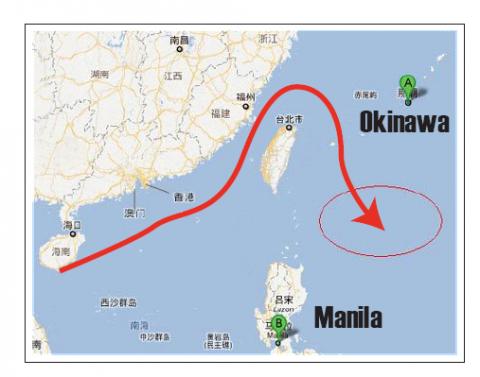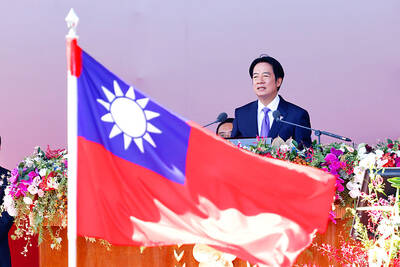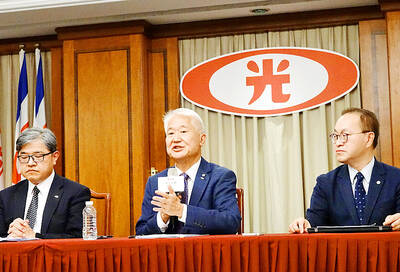The Ministry of National Defense is paying close attention to ongoing maneuvers southeast of Taiwan by a fleet of Chinese navy vessels that includes one of the heaviest combat ships in the People’s Liberation Army Navy.
According to Japanese media, the Japan Self-Defense Forces first spotted the group of five Chinese vessels 650km southwest of Okinawa on Sunday after they had crossed the Strait of Miyako.
The five vessels from the Chinese navy’s South Sea Fleet — Type 052B destroyers Guangzhou and Wuhan; Type 054A frigates Yulin and Chaohu; and Type 071 landing platform dock (LPD) Kunlun Shan — left from Hainan Island and entered the Taiwan Strait, before making a right turn about 180km off Taiwan.

At 18,000 tonnes, the Kunlun Shan is one of the largest combat vessels in the Chinese navy. The LPD, which can support a reinforced battalion of as many as 800 marines and can carry landing craft and medium-sized helicopters, took part in anti-piracy operations in the Gulf of Aden in 2010.
After entering the Pacific, the vessels conducted tactical formation and helicopter training missions in international waters about halfway between Taiwan and the main Philippine island of Luzon.
Aside from a Taiwan contingency, Chinese LPDs could play a crucial role in operations in the South China Sea against countries such as the Philippines and Vietnam, with which Beijing has become embroiled in disputes over contested islets.

Photo: CNA
Commenting on the developments, Deputy Minister of National Defense Chao Shih-chang (趙世璋) told the legislature’s Foreign Affairs and National Defense Committee yesterday that the ministry was closely monitoring the Chinese fleet and that it would continue to pay attention to its movements.
“Because the fleet is in international waters, its presence does not threaten Taiwan’s security for the moment,” he said.
Chao said the ministry believed the Chinese fleet was on a routine training exercise and that it was normal for any country to train their navy in international waters.
An unnamed navy official told the Chinese-language Liberty Times (the Taipei Times’ sister newspaper) that the navy was studying the fleet’s intentions and monitoring whether it would -return to China by the same route or move to another area.
The rapidly modernizing Chinese navy has increased the frequency of its sorties in recent years. A number of those, the latest in February, have made encirclement-like maneuvers around Taiwan.
Many sorties have also taken Chinese vessels to waters near Japan and beyond the first island chain, which Beijing regards as an artificial line preventing it from breaking out as a sea power.
On April 29, three Chinese warships — Type 054A frigates Zhoushan and Xuzhou; and the electronic reconnaissance and missile tracking ship Beijixing — were seen 430km west of the Japanese island of Yakushima in Kagoshima Prefecture. It was the first time in nine years that Chinese navy vessels had passed through the Osumi Strait, which serves as a main transit route for the US Seventh Fleet.
Late last month, the Japanese military reported that Japan Air Self-Defense Force fighter aircraft were scrambled 156 times in response to Chinese naval aircraft approaching Japanese airspace last year, a record high since the Japanese military started releasing such data by country in 2001.
Japan said that flight patterns by Chinese aircraft had diversified, with intelligence-gathering planes becoming increasingly involved.
Additional reporting by Rich Chang

People can preregister to receive their NT$10,000 (US$325) cash distributed from the central government on Nov. 5 after President William Lai (賴清德) yesterday signed the Special Budget for Strengthening Economic, Social and National Security Resilience, the Executive Yuan told a news conference last night. The special budget, passed by the Legislative Yuan on Friday last week with a cash handout budget of NT$236 billion, was officially submitted to the Executive Yuan and the Presidential Office yesterday afternoon. People can register through the official Web site at https://10000.gov.tw to have the funds deposited into their bank accounts, withdraw the funds at automated teller

PEACE AND STABILITY: Maintaining the cross-strait ‘status quo’ has long been the government’s position, the Ministry of Foreign Affairs said Taiwan is committed to maintaining the cross-strait “status quo” and seeks no escalation of tensions, the Ministry of Foreign Affairs (MOFA) said yesterday, rebutting a Time magazine opinion piece that described President William Lai (賴清德) as a “reckless leader.” The article, titled “The US Must Beware of Taiwan’s Reckless Leader,” was written by Lyle Goldstein, director of the Asia Program at the Washington-based Defense Priorities think tank. Goldstein wrote that Taiwan is “the world’s most dangerous flashpoint” amid ongoing conflicts in the Middle East and Russia’s invasion of Ukraine. He said that the situation in the Taiwan Strait has become less stable

CONCESSION: A Shin Kong official said that the firm was ‘willing to contribute’ to the nation, as the move would enable Nvidia Crop to build its headquarters in Taiwan Shin Kong Life Insurance Co (新光人壽) yesterday said it would relinquish land-use rights, or known as surface rights, for two plots in Taipei’s Beitou District (北投), paving the way for Nvidia Corp to expand its office footprint in Taiwan. The insurer said it made the decision “in the interest of the nation’s greater good” and would not seek compensation from taxpayers for potential future losses, calling the move a gesture to resolve a months-long impasse among the insurer, the Taipei City Government and the US chip giant. “The decision was made on the condition that the Taipei City Government reimburses the related

FRESH LOOK: A committee would gather expert and public input on the themes and visual motifs that would appear on the notes, the central bank governor said The central bank has launched a comprehensive redesign of New Taiwan dollar banknotes to enhance anti-counterfeiting measures, improve accessibility and align the bills with global sustainability standards, Governor Yang Chin-long (楊金龍) told a meeting of the legislature’s Finance Committee yesterday. The overhaul would affect all five denominations — NT$100, NT$200, NT$500, NT$1,000 and NT$2,000 notes — but not coins, Yang said. It would be the first major update to the banknotes in 24 years, as the current series, introduced in 2001, has remained in circulation amid rapid advances in printing technology and security standards. “Updating the notes is essential to safeguard the integrity